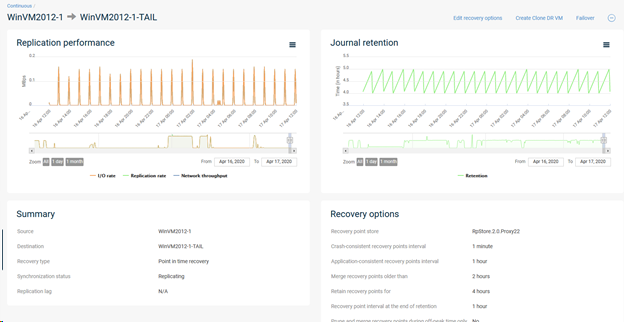From the Replication Monitor, you can view information about the replication pairs that are configured for continuous replication. The monitor can display information for replicated VMs or for file system volumes.
Tiles
-
Summary: General information about replication pairs that use different configuration options.
-
Synchronization status: Current status information for all replication pairs, such as Starting, Replicating, Stopped, or Not synced.
Replication Pairs Table
The Replication Pairs table includes information for each replication pair.
From the list to the right of the Replication pairs heading, you can select All, FS - FS (for file system replication), or VM - VM (for VM replication).
For each pair, the following information appears:
-
Source: The source VM or file system volume. To view the replication pairs properties page, click a source.
-
Destination: The replicated VM or file system volume.
-
Endpoint: The type of replication (File System or Virtualization).
-
VM group: For virtualization pairs, the VM group for the source VM.
-
Replication group: The replication group where the replication pair is configured.
-
Recovery type: The type of recovery that is available at the destination site: Latest recovery (only the latest copy of the source) or Point in time recovery (multiple recovery points).
-
Synchronization status: Current status information for the replication pair, such as Starting, Replicating, Stopped, or Not synced.
-
Status description: Additional information for the synchronization status.
-
Replication lag: For pairs that are configured for point-in-time recovery, the delay in applying updates for recovery points.
-
Recovery point store: The store that records application-consistent recovery points (ACRPs) and associated updates as point-in-time recovery points for each replication pair.
-
SLA Status: Current status condition for the SLA. These conditions are:
-
Met SLA: Replicating, Replication with problems, and no lag.
-
Missed SLA: Suspended and lag time Replicating and Replication with problems with lag.
-
Not applicable: Replication status: Stopped, Resyncing, Starting, failing over, failover done, failing back, suspended, and failover failed.
-
-
Test failover status: Current status information for a test failover operation. You can click the link in the status to view the corresponding job.
-
Test failover description: Additional information for test failover status.
-
Clone DR VM status: Current status information for a DR VM clone operation.
-
Clone DR VM description: Additional information for the clone status.
-
Test failover status: Current status information for a test failover operation.
-
Test failover description: Additional information for the test failover status.
-
Clone DR VM status: Current status information for a clone DR VM operation.
-
Clone DR VM status description: Additional information for the clone DR VM status.
-
Replica copy: For file system replication, shows information about replicated volumes at the destination computer.
-
Replication copy details: For VM replication, shows information about replication copies at the destination.
-
Action: You can select the following options for a replication pair:
-
Create Clone DR VM (VM replication): Create a clone of a VM for disaster recovery.
-
Create replica copy (file system replication): Create a replica copy to make volumes available on the destination computer for continued operation.
-
Create test failover (VM replication): Temporarily start the destination VM.
-
Delete pair: Remove the replication pair from the monitor and the replication group.
The destination VM or file system volume is not removed when you delete the replication pair.
-
Edit recovery options: Change the options for recovery at the destination site.
-
Edit replication volume (file system replication): Modify the settings for volume replication from the source computer to the destination computer.
-
Planned failover (VM replication): Perform a planned failover to the DR VM during maintenance on the primary VM.
-
Unplanned failover (VM replication): Perform an unplanned failover to the DR VM in an emergency.
-
Resume: Continue a replication operation that was suspended or failed.
-
Resync: Reapply updates from the source to the destination.
-
Schedule Clone DR VM (VM replication): Specify a schedule for cloning a VM for disaster recovery.
-
Schedule test failover (VM replication): Specify a schedule for performing a test failover operation.
-
Start: Begin replication for a pair when replication is stopped.
-
Stop: Stop replication.
Note
If you stop replication, existing recovery points are discarded when you restart replication.
-
Suspend: Pause replication.
-
Test failover (VM replication): Perform a test failover to the DR VM.
-
Replication Pair Properties
In the Continuous Replication Monitor, under Source, you can click a replication pair to view detailed information for the pair.
The following information is included on the properties page for a replication pair:
-
Replication performance: This tile displays an interactive graphic that summarizes the I/O rate, replication rate, and network throughput for the replication pair. You can select a performance statistic to change the display, and select a point or a range on the graphic to examine statistics more closely.
-
Journal retention: This tile displays an interactive graphic that summarizes the journal retention for recovery points for the destination VM. You can select a point or a range on the graphic to examine statistics more closely.
-
Summary: This tile provides information about the replication pair.
-
Replication volumes: For file system replication, shows the mapping between source volumes and destination volumes.
-
Recovery options: For replication pairs that are configured for point-in-time recovery, this tile provides information about the configured options for recovery at the destination site.
-
Replica copy: For file system replication, shows information about replicated volumes at the destination computer.
-
Replication copy details: For VM replication, shows information about replication copies at the destination.
The following image is an example of the properties page for a VM replication pair:
